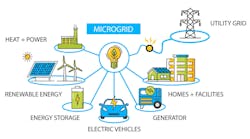Microgrid Knowledge Names Three Winners of the 2021 Microgrid Greater Good Awards
This year’s Microgrid Greater Good Award winners provide essential services to refugees in Uganda, electrify a birthing clinic in Kenya and keep food fresh and safe in South Australia.
The awards were announced today at Microgrid 2021, a virtual conference hosted by Microgrid Knowledge.
Microgrid Knowledge launched the award program three years ago as a way to highlight the humanitarian and societal benefits of microgrids. The winners are chosen by a panel of independent judges.
Of note this year, one company, Schneider Electric, participated in developing two of the winning projects.
Assisting South Sudanese refugees
The top prize went to a containerized microgrid at the Ayillo II Refugee Settlement, which serves South Sudanese refugees residing in Northern Uganda.
Called the ATLAS Containerized Microgrid, the system powers a 40-foot container that was converted by an Arizona State University (ASU) team into a medical clinic that provides primary care to over 200 refugees per day.
Before the microgrid was installed, medical practitioners struggled with unreliable power and difficult access to clean water.
The clinic uses 22 linear feet of the 40-foot container, with the remaining 18 feet used for the microgrid and water purification systems. The 10-kW solar microgrid also provides power for medical staff housing and is capable of offering additional power for expanded water supply and area lighting.
The containerized microgrid is replicable and can be used for other areas that require “last mile” distribution to remote off-grid locations, according to ASU Professor Nathan Johnson, who led development of the system as part of a $2 million, four-part research project funded by the US Office of Naval Research’s Defense University Research-to-Adoption Program.
ASU worked on the Ayillo project in partnership with Medical Teams International, which operates clinics in refugee settlements in many parts of the world. Other partners are Pipeline Worldwide, SolarNow Uganda, Industrial Water Innovations, Corporate Interior Systems, Wholesale Floors, Gensler, Tarkett and the US Office of Naval Research.
Patrice Calise, one of the Microgrid Greater Good Award judges and associate copy editor at S&P Global Market Intelligence, described the microgrid as “a true multitasker that addresses multiple challenges.”
“The model of containerized, relatively easily deployed medical units with a self-sustaining microgrid does so much heavy lifting in communities that have many gaps to fill,” she said.
Other judges were Housley Carr, writer/analyst at RBN Energy; Peter Kelly-Detwiler, principal, NorthBridge Energy Partners; Melissa Marshall, director of operations for the Partnership for Inclusive Disaster Strategies/policy advisor for the World Institute on Disability; Mary Powers, special correspondent, Engineering News-Record.
Microgrid for Kenya birthing clinic
A microgrid that brought reliable electricity for the first time to a women’s clinic in Kenya won the award for a microgrid at a remote location.
Located at the Matongo Women’s Clinic, the 8.7-kW solar and storage microgrid led to a dramatic increase in births at the clinic. Before it was installed, women were hesitant to make the journey to the clinic because of its frequent power outages, said Samantha Childress, a solutions architect manager at Schneider Electric and a member of the board of directors for United Solar Initiative. Both organizations worked on the project, along with Kenyan solar installer Powerpoint and NGO funding partner Curamericas.
Matongo Women’s Healthcare Clinic & Birthing Center of Kisii County, Kenya. Courtesy of United Solar Initiative
The microgrid provides backup power to critical loads at the birthing center which incurs weekly power outages. Since the microgrid went on online in August 2020, the birthing clinic has seen a significant rise in the number of births. In addition, the facility is saving money on energy, which allows for the purchase of additional medical supplies.
Mary Powers of Engineering News-Record said she chose the Matongo Women’s Clinic because “Kenya’s maternal death rates and stillbirth rates are a major public health concern. Additional births in better conditions improve both maternal survival and live births.”
Melissa Marshall of the Partnership for Inclusive Disaster Strategies said she was impressed at the team’s ability to continue to develop the project remotely during the pandemic. “Remote development keeps the carbon footprint lower, and it preserves staff and other resources.”
Protecting the food supply from power outage
The South Australian Produce Market, which employs a sophisticated microgrid control system, won the award for Grid-Connected Microgrid.
South Australia went through complete statewide extended blackouts in 2016 because of grid failure. When the produce market lost power, the impact was felt widely — it is the main source of fresh fruit and vegetables for Adelaide, South Australia’s capital and the fifth largest city on the continent.
On top of that, farmer tenants were already paying the highest electricity rates in the country in the embedded network.
South Australia Produce Market, Courtesy of AZZO
The blackout and high energy prices prompted the South Australian Produce Market to take control of its energy supply by installing a 7.5-MW microgrid that uses solar, battery storage and a fuel-efficient generator as the last resort.
The microgrid has reduced energy costs for farmers and given them confidence that they will not lose product because of power outages.
The project features AZZO’s automated spot market bidding system that allows the produce market to gain revenue by buying and selling energy to the grid based on real-time pricing in the National Electricity Market.
“The South Australian Market project won my vote because of the effort made to optimize the grid-connected nature of the project,” said NorthBridge’s Peter Kelly-Detwiler. “The intelligence in the system that essentially forecast and arbitraged prices in the Australian energy market with those in the microgrid offers an example of the power of these systems to lower everybody’s prices by being price-elastic. Customers in the market saved 25%, while enjoying a level of reliability they could not previously count on. I look forward to the day when these types of projects no longer require government subsidies: as costs of the constituent elements continue to fall, and our body of expertise grows, I suspect that day is not far away.”
Subcribe to the free Microgrid Knowledge Newsletter for news of the call for submissions for the Microgrid 2022 Greater Good Award.







